
|

|

|

|
|
Alex and Terri's Yorkie Care FAQ Pages |
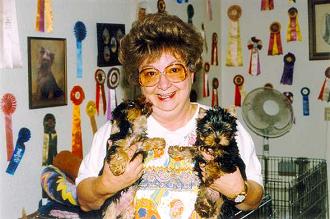
Terri and her cute Yorkie Puppies |
 My puppy hasn't eaten and is lethargic. Could it be hypoglycemia?
My puppy hasn't eaten and is lethargic. Could it be hypoglycemia?
|
|||||

However, in a young puppy, or a very tiny toy dog, this condition is usually hypoglycemia, brought on by stress or shock in some form. Also, it usually occurs in puppies from 4 to 5 months of age but CAN occur in mature toy breeds when they are subjected to STRESS. The stress usually causing this condition is: 1- Overhandling young puppies and not letting them get enough rest and sleep. 2- A puppy refuses to eat for over a period of 8 hours due to change of home and/or food. 3- Exposure to low room temperatures for a period of time or sleeping in drafts. The puppy will appear limp and lifeless with the gums and tongue usually grayish blue in color. Often the eyes are unfocused and barely open. They may appear to be slightly sunken in. Temperature will be sub-normal and the puppy will be shivering and trembling in the early stages. As condition worsens, the puppy either goes into a coma or convulsions. Hypoglycemia is a metabolic disorder and death will result, unless properly DIAGNOSED AND CARED FOR IMMEDIATELY, if the case is severe. The level of the blood sugar must be raised at once and the stress condition treated. My Vet recommends an injection of 5-10 cc of a five percent solution of dextrose with added B-12. He gives this subcutaneously as it provides a longer lasting action and, also, it is almost impossible to locate a vein in a tiny puppy. With this dextrose or glucose, my Vet also gives an injection for shock and stress. He says that many Vets use a form of cortosteroid for this stress factor. It is produced under many trade names, but your Vet will be sure to have it on hand. When these injections are given in time, the puppy may regain consciousness promptly. If the seizure is bad or not CARED FOR IN TIME, the puppy may REMAIN IN A COMA FOR DAYS. When this happens, you must feed him, keep him warm and quiet and see that he has proper eliminations. Usually the bowels will move without help, but an older puppy may struggle to be supported erect on his feet for elimination. Check carefully for urination as the pup is in trouble if the kidneys cease to function. Wash genital area with cotton soaked with warm water if the puppy is comatose. If partially mobile, put his feet on a towel at the edge of a wash basin. Support him with one hand and turn the water on in the basin. Hearing the running water usually makes them urinate. Also, Mix the Glucose Solution shown in "Whelping Supplies" or Mix Honey, Sugar or Corn Syrup with equal amounts of water and feed with syringe 10cc four times a day. When hypoglycemia is caught in time, there is no reason why a puppy won't come out of it and never have it again if the stress factor is eliminated. Even if this never occurs to your puppy, or adult, it is important that you know about this to aid your Vet in diagnosing the problem. This usually affects Tiny Toy Breeds and Most of them outgrow this danger by 6 months of age. However, it can happen to a tiny dog even as an adult and careful attention must be paid to the diet of any TINY TOY DOG.  My Yorkie needs surgery. What should I know about anesthesia and intubating?
My Yorkie needs surgery. What should I know about anesthesia and intubating?
|
|||||
 There are a couple of different dangers in surgery for toy dogs and they are
not insurmountable, but they are VERY SERIOUS.
There are a couple of different dangers in surgery for toy dogs and they are
not insurmountable, but they are VERY SERIOUS.
1) DON'T ever allow the vet technician to intubate your toy dog. Too many small toy breeds have had TRACHEAL INJURY and suffered and DIED because of collapsing tracheas from injury to the trachea during intubation. Make sure that the vet knows that you expect him/her to use the smallest possible tracheal tube to intubate your toy dog. Speak up! It could mean saving the life of your little dog. If the vet treats you like an "overprotective" Mom, find another vet that will understand. 2) Proper use of Ace Promezaine as a pre-anesthetic injection is ok so that the dog can be intubated. 3) Isoflurane is the anesthetic of choice. Don't use Halothane or any of the barbituates (see number 4, below). Some vets will "mask" a tiny dog with Isoflurane rather than use the injectable and some vets will not intubate at all, but this depends on the type of surgery being performed. This is an excellent method whenever possible. 4) Last but not least, DO NOT ALLOW YOUR VET TO USE ANY KIND OF BARBITUATES TO ANESTHESIZE YOUR TOY DOG. MOST PARTICULARLY NOT PENTABARB. Many toy dogs have died needlessly because of UNINFORMED VETS WHO ARE DECADES BEHIND IN USE OF ANESTHETICS FOR TOY DOGS. If your vet thinks Isoflurane is too expensive and refuses to use it, then FIND ANOTHER VET THAT will use it. It could and probably will save your dog's life.
 What is Liver Shunt?
What is Liver Shunt?
|
|||||
 The symptoms of portacaval liver shunt can start
to appear at almost any age. Dogs with a liver
shunt are usually very thin dogs who pick at food.
They not only have a poor appetite but they can
become lethargic, dizzy, and stagger. They may
try to climb out of their pen, climb higher on you
and cry and throw their head far back after eating,
and they may go into convulsions.
The symptoms of portacaval liver shunt can start
to appear at almost any age. Dogs with a liver
shunt are usually very thin dogs who pick at food.
They not only have a poor appetite but they can
become lethargic, dizzy, and stagger. They may
try to climb out of their pen, climb higher on you
and cry and throw their head far back after eating,
and they may go into convulsions.
This is not a new disease but one which is coming to the attention of all Yorkshire Terrier breeders and other toy breeders in the 80's and 90's and many breeders feel that it is an inherited disease and that the only way to eliminate that disease is to cull those dogs who are affected and producing this disease from their breeding program. This disease usually goes hand in hand with a kidney disorder and it seems that a special diet can sometimes keep it under control with some dogs for a time. Surgery sometimes works depending on where the "shunt" is. What happens is that the blood by-passes the liver and goes directly to the heart and therefore the liver shrivels up, becomes filled with infection and the dog convulses. These dogs so affected are unable to cope with barbiturates. We accidentally found this out in '86 when I dosed my dogs with Ace Promazine for travel sickness and one "sickly" girl puppy slept as though she died. She did come around the next day. Later we associated this with her condition when she convulsed and died at 12 weeks. An autopsy revealed an infected and shriveled up liver, the result of a liver shunt. The Yorkshire Terrier Foundation is in the process of trying to clinically prove that this is an inherited disease, but I have proven to myself that it is because of my own test breeding and eliminating those dogs involved which thereby ended my problems now for many years. There's always the possibility that this is the first time it happened to a breeder. Hey, there was a first time for me too!! It's not SHAME ON YOU for having the problem, but it is SHAME ON YOU if you, as a breeder, don't take steps to see that it doesn't happen again. If your dog shows any of these symptoms, the blood tests alone and the bile acid tests are INCONCLUSIVE. If the dog dies, have your veterinarian do a simple autopsy to examine the liver. Do not just put the dog to sleep because the blood test has an elevated white count and the veterinarian THINKS it may be the liver disease. Unless the dog is extremely debilitated, it may not be the liver disease and you will have put him/her down for no reason. There are various specialists who *know* how to recognize the disease so that you are certain that you are getting an accurate prognosis. We will add more connections for information on liver shunt as it becomes available. In the Dallas Ft Worth, Texas area: Dallas Veterinary Surgical Center. Dr. Robert D. Barstad Phone: 972-235-2096 Fax: 972-680-0859 He is one of only two in the state of Texas that does this surgery and is reported to have a 95% success rate. Cornell University - Ithaca, New York Phone: 607-255-2000 Dr. Susan Center at Cornell has been quite helpful with liver shunt pups. She has at times done surgery free and spayed/neutered, and rehoused donated pups. Her email address is sac6@cornell.edu. She is quite knowledgeable, has kept some in her home, and is currently studying diet along with surgical repairs. University of California at Davis, California Dr. Clare Gregory Dr. Karen Tobias University of Tennessee College of Veterinary Medicine PO Box 1071 Knoxville TN 37901-1071 (865-974-8387). Dr. Tobias is undertaking a genetic evaluation of Yorkies with shunts. "I have no idea whether we will find that this disease is more prominent in one line, or if it's polygenetic. We would hope that all breeders would be interested in clearing this disease from their lines and would welcome the results. The study has been completed in Australia, where they have shown that breeding 2 Maltese dogs with shunts will result in a 25% incidence of portosystemic shunts. We have not performed any breeding studies of Yorkshire terriers, but will start with the basic genetics, and will give the information to the next group, which is planning on trying to find an actual genetic marker. Imagine that- a blood test to diagnose the propensity for shunts! I am not familiar with what will be involved, but I think the possibilities are incredible. I imagine we could test every Yorkie and selectively breed this disease out of the population."
Dr. Cynthia M. Smith. State of Washington 253-588-1851 Washington State University College of Veterinary Medicine. Anthony J. Cambridge, B.V.M.S.,M.A.C.V.Sc.,M.R.C.V.S Resident of Small Animal Surgery. E-mail: tc@vetmed.wsu.edu Liver Shunt Experts experienced at liver shunt surgery: Auburn University: (334)484-44690 Florida State University: (352)392-4746 Dr. Michael Petranto, Twin Rivers, NJ: 609-426-9625 Dr. Kazmierczak, West Trenton, NJ: 609-771-0995 Hopewell Vet Group, Hopewell, NJ: 609-466-0131 Terri Shumsky Fanny Mae Liver Shunt's Fund c/o Lorraine Iervolino 316 Gladstone St. Corsicana TX 75110-1857 903-872-2807 tsfmls.fund@gmail.com Jon-An's Yorkshire Terriers Liver Shunt Information Lacy's Liver Shunt Information Meet Star, a Liver Shunt Baby Meet Rayna, another Liver Shunt Baby UC DAVIS is working in conjunction with AKC Canine Health Reserach to establish the normal DNA for healthy dogs. You can send for the swabs and help by being a part of this data base collection by going to http://www.vgl.ucdavis.edu/Service/Canine/#kit and applying for the swabs for your dogs. Additional information is at http://www.vgl.ucdavis.edu/research/canine/. Also Catherine Inverson, Research Vet, is interested in DNA Swabs from the parents of Liver Shunt Victims in an attempt to find the DNA responsible for this problem. She can be reached at healthydog@vetgen.com. Thank you for your participation.  What is a Teacup Yorkie? Is that just backyard breeder hype?
What is a Teacup Yorkie? Is that just backyard breeder hype?
|
|||||
 Yorkies according to history were always a small dog, but outcrossing in many cases has caused some larger dogs.
There is speculation that some "breeders" have used Silky Terriers and registered them as Yorkshire Terriers.
This could happen in kennels where they have more than one breed. They have been bred for 50-60 years as a
toy dog which averages 4-6 pounds... there are occasionally 2-4 pounders and occasionally 7-9 pounders.
Mice have been mice for thousands of years and therefore the size is more predictable.
Yorkies according to history were always a small dog, but outcrossing in many cases has caused some larger dogs.
There is speculation that some "breeders" have used Silky Terriers and registered them as Yorkshire Terriers.
This could happen in kennels where they have more than one breed. They have been bred for 50-60 years as a
toy dog which averages 4-6 pounds... there are occasionally 2-4 pounders and occasionally 7-9 pounders.
Mice have been mice for thousands of years and therefore the size is more predictable.
Most breeders will not breed a female under 4.5 or 5 pounds because to do so would be cruel and probably cause a C-section or other problems with a crowded uterus, so those that are too small to breed are sold as Tinies... (not tea cups and not miniature... just tiny). Also, small males 2-3 pounds, make breeding a little more difficult, though possible, due to the size of the male in comparison to the size of the female, so most breeders settle on a 4-7 pound size as a preference. It is possible therefore, for pups in the same litter to mature anywhere from 3 to 8 pounds in the same litter. The terminology "tea cup" size came about in the 70's when the breed became more popular than the poodle which had three sizes, toy, miniature and standard. Poodle people would differentiate between toy and very tiny poodles by calling them tea cup meaning they could sit in a tea cup and were tiny. As this size differential doesn't exist in Yorkshires, the terminology is incorrect and seems to be used by some breeders to extract a higher price for the puppy as a "tea cup size." It simply means "tiny." I would venture to guess that legitimate, reputable breeders probably come up with 60% between 4-7 pounds at maturity and 20% under 4 pounds and 20% in the 7-9 pound range. Weight is a consideration but depending on the muscle and bone in a particular dog, they can weigh more or less than you think, i.e. a 12 inch at shoulders dog could be 7 lbs and be very skinny and fine boned, while a 9.5 inch at shoulders could also be 7 lbs. and look much smaller because it carries more muscle and bone. For more information on weight history go to http://www.geocities.com/~dugmore/weighthistory.html.  What is a Chocolate Yorkie? Is it rare?
What is a Chocolate Yorkie? Is it rare?
|
|||||

 It is my understanding that AKC has many colors on their list that will allow
almost any color Yorkie to be registered and the parent Club is working to
disallow that. I have been approached by people who have registered this color,
even though it is incorrect for our breed. There is no reason that they cannot be
placed in a loving pet home and live a good life, but they are definitely a mutation
to our breed and not in line with the Standard we want to withhold.
It is my understanding that AKC has many colors on their list that will allow
almost any color Yorkie to be registered and the parent Club is working to
disallow that. I have been approached by people who have registered this color,
even though it is incorrect for our breed. There is no reason that they cannot be
placed in a loving pet home and live a good life, but they are definitely a mutation
to our breed and not in line with the Standard we want to withhold.
Those that advertise this color as RARE are being dishonest in that they are just trying to enrich themselves with more money, in spite of the lack of pigment in the dogs they produce which could bring a genetic nightmare to the breed. Don't be taken in by this false advertising.  What shall I do for my Yorkie's bloody diarrhea and what is HGE?
What shall I do for my Yorkie's bloody diarrhea and what is HGE?
|
|||||

Is it Parvo, Corona, Giardia, or Cambylobacter Enteritis? Any kind of bacterial diarrhea can quickly dehydrate an animal and the tinies are in great peril as they have little weight to lose before they are dehydrated and need IV rehydration. Your dog can be infected by a walk in the park, or at a dog show, or other congregation of dogs. Anywhere from 2-10 days from exposure, your dog can come down with this problem, starting with vomiting, lethargy, refusing to eat, and progressing to mucous covered stool, loose stools, profuse diarrhea and bloody diarrhea. Though it is important that your dog is placed on wide spectrum antibiotics, it is important that a culture be done first so that you know exactly what bacteria you are treating. Many cases of Hemorrhagic Gastric Enteritis are treated with a combination of Amoxicillin and Flagyl, but both these drugs will probably be recommended by your veterinarian at the first sign of bloody diarrhea and vomiting. DO NOT waste time, particularly with the smaller breeds, as they have little reserves to lose fluid thru diarrhea, especially bloody diarrhea. My vet has instructed me to go ahead and give the Amoxicillin 50 mg two times a day (toy dogs) and if there is no change in 12 hours to bring the dog in for further evaluation. I have seen severe bloody diarrhea, bright red blood, stopped after administering Amoxicillin as my vet instructed, along with kaopectolin or other anti diarrhea agent from your vet. In a more severe case, he also had me give Flagyl at the same time. Consult your veterinarian for proper dosage by weight of your dog.  My Yorkie has a dry hacking cough that sounds like something is stuck in her throat.
Could it be tonsilitis?
My Yorkie has a dry hacking cough that sounds like something is stuck in her throat.
Could it be tonsilitis? |
|||||
 Yorkies are prone to tonsilitis, especially if they go outside to make and
get a chill, or if someone in the family has a "strep" sore throat -- They will
"get it"...to be sure. A tonsilectomy is called for ONLY IF THE TONSILITIS
BECOMES CHRONIC, but in the meantime treating the tonsilitis with
Amoxicillin 50 mg 2 x day and temaril p (antihistimine with prednisilone) keeps
down the inflammation and the mucous. Be sure to use the Amoxicillin for 10
days.
Yorkies are prone to tonsilitis, especially if they go outside to make and
get a chill, or if someone in the family has a "strep" sore throat -- They will
"get it"...to be sure. A tonsilectomy is called for ONLY IF THE TONSILITIS
BECOMES CHRONIC, but in the meantime treating the tonsilitis with
Amoxicillin 50 mg 2 x day and temaril p (antihistimine with prednisilone) keeps
down the inflammation and the mucous. Be sure to use the Amoxicillin for 10
days.
If the dog has tonsilitis regularly like every other two weeks or once a month, then I would consider doing a tonsilectomy. Kennel cough (traceobronchitis) is a cough with congestion usually and lasts about 30 days. Treatment is pretty much the same except an expectorant (childs cough syrup) might be called for, if the congestion is bad. Kennel Cough is usually the case where dogs congregate and are in a closed area -- Like a benched indoor kennel club show where no fresh air is circulating. From what you described, a "clearing of the throat" sounds like tonsilitis. Another way to tell if the tonsils are swollen is because you can feel little lumps swollen also when tonsils get infected. The lumps are just at the angle of the jaw bone. Another thing that you might want to check if the cough is persistent is the trachea. An x ray will show if there is trachea damage or an inherited trachea problem. Some small dogs that are anethesized to have teeth pulled, etc. need very small tubes to be inserted and if the technician forces a tube in the trachea that is too big, it can cause tracheal damage and this is something I've heard of many times before. Always insist that your VET intubates your toy dog with a small as possible tube so that the trachea is not damaged. I put this on my bill of sale for the client to take to the vet because I feel it is so important. If you like, you can discuss this letter and the attachments about tonsilitis, tracheobronchitis, and collapsing trachea and damage with our vet. It may help and if your vet thinks I'm nuts for suggesting it after 30 years of raising these little dogs, then you need to find another vet. There can be a weakness in the trachea and if it collapses the dog cannot breathe. Emergency surgery and inserting plastic devices or coils can be done in some cases to keep the dog alive. This can be caused by severe hacking from a cold or it can be a congenital thing. Symptoms -- A loud honking, dry cough. Gasping, unable to breath. KENNEL COUGH A mild, self-limiting disease, involving the trachea and bronchi of dogs of any age. It spreads rapidly among animals that are closely confined as in hospitals or in kennels. Environmental factors such as cold, drafts and high humidity apparently increase susceptibility to the disease. The incubation period is 5 to 10 days. The outstanding sign is a harsh, dry cough, which is aggravated by activity or excitement. The coughing occurs followed by retching or gagging in attempts to clear small amounts of mucous from the throat. Reverse sneezing is noted in some cases. Gentle pressure over the larynx or trachea will induce a cough. Body temperature is normal in the early stages but may be elevated as secondary bacterial invasion takes place. The most severe signs are noted during the first five days, but continue in some degree for 10 to 20 days. Treatment - Keep warm (not hot) and quiet. An expectorant like Benadryl Children's Antihista-mine/Nasal Decongentant (dosage 1 to 1 1/2 ml-two times a day) and though antibiotics have no effect on the primary disease and it will have to run its' course, they may be used to good effect in controlling secondary bacterial infection, which could lead to pneumonia if unchecked. Amoxicillin is my Veterinarian's choice as a primary antibiotic. 50 mg two times day for ten days. Whether or not to vaccinate your dogs against Bordatella (another respiratory disease) probably depends on your exposure. If they are to be kennelled or shown at indoor shows during the cold winter months, then it is probably a very good idea to have your veterinarian give this vaccination which is very effective. It may give your dog a mild case of the disease, but can be beneficial if the exposure is a threat. Most toy dogs are prone to tonsillitis when the weather changes and there are severe temperature fluctuations and don't let anybody kid you a tiny toy dog can die from tonsillitis if left untreated. It is important that you know the symptoms and treatment for this because the symptoms can be confused with other gastritis problems and waste valuable time in treatment. Toy dogs can not afford to lose too much weight, particularly the tiny ones. The first sign of tonsillitis is refusing to eat, that progresses to lethargy, swelling of the salivary glands (just below the jaw bones) and if you can open the mouth and depress the tongue you will see that the tonsils are inflamed and enlarged, the back of the tongue is affected and red and swallowing is difficult. If left untreated, the dog will be swallowing mucous and the next sign you'll see is mucous in the stool. Depending on the size of the dog this will progress to a severe gastritis and thereby produce mucous stool and later yet bloody stool. The dog does not necessarily run a fever through this episode. If this toy dog is very small; that is, a three or four pound dog, and you have delayed getting to the veterinarian, you have one very sick dog who may even be too weak to stand or convulsing. The dog as presented to the Vet could be suffering from any one of many different diseases, so the first thing he may do is suggest a blood test and fecal test, etc. to rule out any infectious diseases. Now you are weakening an already weak dog. It won't hurt to mix the formula for a pregnant sick bitch in Whelping and Sick Puppy and syringe the dog to keep up it's strength. Also give pepto bismol mixed with Nutri-Cal to coat the stomach. Ask your Vet to check the throat and salivary glands on your dog to rule out tonsillitis before taking blood and if the tonsils are inflamed treat the dog as follows: 50 mg Amoxicillin 2 times a day for ten days 1/4 temaril P 2 x day for 3 days, 1 x day for 2 days...every other day 3 x.... (do not give temaril p or any steroid if pregnant) Temaril P is a combination drug which is no longer available, but your vet can prescribe another similar drug which will help your dog to recovery. The Amoxicillin will attack the infected throat and the temaril P is an antihistamine with prednisolone which will take down the inflammation so the dog will start to eat again. Within a day or so if the dog isn't any better, THEN IS THE TIME TO START blood tests and whatever else is necessary. If Amoxicillin is going to work, you should see results in 24 hours. Any antibiotic therapy must be continued for the full duration of 7 to 10 days. Don't stop giving it mid-stream. To do so will only mean that next time you need that antibiotic, it may not work! DO NOT ALLOW YOUR TOY DOG TO GO WITHOUT EATING FOR MORE THAN ONE DAY WITHOUT SEEKING A SOLUTION. MIX THE GRUEL AND SEE IF THEY KEEP IT DOWN. Remember your last sore throat and how hard it was to swallow. Dogs won't eat if their throat hurts!  How in the world do you tie a Yorkie's hair in a topknot?
How in the world do you tie a Yorkie's hair in a topknot? |
|||||
 Doing a topknot is not the big five elastic band with teasing and
hair spray that some people make of it. We finished many
Champions with a plain old simple topknot like you'll see
illustrated in the next two figures. All that teasing wrecks
the hair and the hair spray can cause serious damage to the eyes!!
Doing a topknot is not the big five elastic band with teasing and
hair spray that some people make of it. We finished many
Champions with a plain old simple topknot like you'll see
illustrated in the next two figures. All that teasing wrecks
the hair and the hair spray can cause serious damage to the eyes!!
I usually don't start doing topknots until they're about 10 months, and even then you have to redo it every day and keep their nails short or they'll rip up their hair. 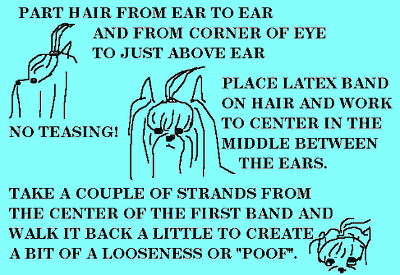
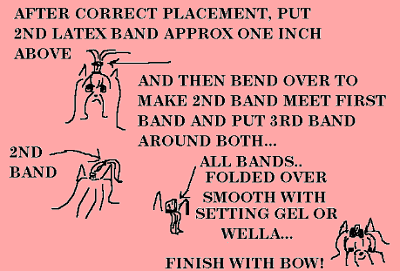
 My dog has black slimy ears now and I was told this was winter ear. What can I do about it?
My dog has black slimy ears now and I was told this was winter ear. What can I do about it? |
|||||
 Leather ear, slick ear, English ear, black ear does
affect some toy dogs, namely Yorkies, rather
seriously. It can be responsible for hair loss on the
ears, hocks, and the end of the tail and leaves a
slimy black substance in those places. Some
people think it is a fungus and some think it is a
"rabbit mite". Frankly, having spent hundreds of
dollars in the 70's to cure it, I still can't tell you
what it is but I can tell you how to keep from
getting it or how to get rid of it once you've "got it".
Leather ear, slick ear, English ear, black ear does
affect some toy dogs, namely Yorkies, rather
seriously. It can be responsible for hair loss on the
ears, hocks, and the end of the tail and leaves a
slimy black substance in those places. Some
people think it is a fungus and some think it is a
"rabbit mite". Frankly, having spent hundreds of
dollars in the 70's to cure it, I still can't tell you
what it is but I can tell you how to keep from
getting it or how to get rid of it once you've "got it".
At the first sign of black around the edges of the ear, wipe the ear with "dog-o-dontic pads" dipped in alcohol. Bathe in Betadine or Plexadine Shampoo, paying particular attention to the ears, end of tail, and hocks. Use Ear Guard by Gerard Pellham regularly in the ears and cover the ears, hocks, and end of tail with a thin coating of Lotrimin 1%....no other kind of Lotrimin...just Lotrimin 1%, every day until the problem is solved! You will notice the ear begin to get very dry. Stop using the Lotrimin 1% if the ears get too dry! Another product which I have recently used for this problem is #l All Systems Tea Tree Oil and I'm happy to say that it works! This stuff is also really good to spray on "wrappers" as it is not too tasty! Softer coated dogs never seem to have a problem with this but the silky coated dog with a lower skin temperature seems to have a problem when colder weather and high humidity prevail. Keep the dogs warmer and wash them at least once a week using Betadine or Iodine shampoo in those areas which are susceptible. You will be in control if you follow these instructions. It is also a good idea to have your veterinarian do a thyroid function test on dogs with these symptoms because some dogs with this problem also have a low thyroid function and medication may help the situation and keep the dog from becoming sterile and the bitch from having unusually small litters.  Why does my puppy eat his stool?
Why does my puppy eat his stool?
|
|||||
 This is a common problem and though this is somewhat disgusting to us as
they then give us kisses. It probably has something to do with the
fact that our dog foods are so good today without chemical preservatives
that they don't seem to think it matters to recycle.
This is a common problem and though this is somewhat disgusting to us as
they then give us kisses. It probably has something to do with the
fact that our dog foods are so good today without chemical preservatives
that they don't seem to think it matters to recycle.
If you sprinkle some meat tenderizer on the food, this should help deter the dog from thinking it tastes good. That and VERY QUICK cleanups, usually solve the problem.  My dog is always rubbing his butt on the ground. Does that mean he has worms?
My dog is always rubbing his butt on the ground. Does that mean he has worms?
|
|||||
 Nope, not usually, that is an old Wive's tale. It usually means that the
anal glands need to be emptied. Have your vet check the anal glands and
show you how to relieve these glands every time you shampoo and the problem
will probably never reoccur.
Nope, not usually, that is an old Wive's tale. It usually means that the
anal glands need to be emptied. Have your vet check the anal glands and
show you how to relieve these glands every time you shampoo and the problem
will probably never reoccur.
 I'm pretty domestic. Can I make toys for my Yorkie?
I'm pretty domestic. Can I make toys for my Yorkie?
|
|||||
 Yes, how about crocheted ruffle balls? Yorkies love them and throw them all over the place.
Yes, how about crocheted ruffle balls? Yorkies love them and throw them all over the place.
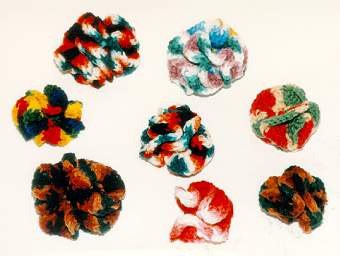 Materials needed:
Materials needed:scissors G crochet hook bright colored 4 ply yarn Chain (ch) 5 slip st to lst stitch ch 1.....single crochet (sc) 3 x in each stitch (15 stitches) slip stitch into last stitch ch 1 do 3 sc in each stitch around alternating 3 sc and 4 sc all the way around in each stitch join with slip stitch ch 2, double crochet in each stitch around...slip stitch and weave end.... Throw Ball for Puppies to run and Catch and Shake!!!!
 How can I make a comfortable Cuddle Bed for my Yorkie?
How can I make a comfortable Cuddle Bed for my Yorkie?
|
|||||
 Get 1 1/2 yards of 60 inch material. A little stretch to the fabric is ok,
but not too much or your bed will take too much polyester stuffing and not
stand right. I prefer a soft velour, or imitation suede.
Get 1 1/2 yards of 60 inch material. A little stretch to the fabric is ok,
but not too much or your bed will take too much polyester stuffing and not
stand right. I prefer a soft velour, or imitation suede.
You will need 4 bags of 20 oz stuffing and about one yard of 1/2 inch batting. This will make two cuddle beds.
 Can I make bows for my Yorkie's topknot?
Can I make bows for my Yorkie's topknot?
|
|||||
 Here's how I make my double bows:
Here's how I make my double bows:
Materials needed: 1) Satin ribbon, 3/4 inch (approx) Red, Orange, or Bright Blue preferred 2) plastic barettes with metal clips (package different colors in drug stores) or clip on metal barettes about 1 1.2" (beauty supply or craft shop) or orthodontic latex bands Med Weight 3) Hobby Paint - the kind you use on model cars and planes 4) Sobo glue 5) glue gun 6) red or white dental floss 7) scissors 8) sprinkle glitter and pearls or stones 9) 4 #11 knitting needles 10) small hemostat 11) needle and thread 12) Spray from craft shop that makes material STIFF If you're using the barette clips from the beauty supply, you don't have to paint them, but if you're using the plastic barettes from the drug store, you'll want to use your dremel to take off the extra "gingerbread lace stuff" and just have a "plain barrette." You can paint it then the color of your ribbons. Put all this stuff in a box....next time you watch the TV....you've got something to do with your hands. Cut ribbon to 8" pieces, fold in half, stitch accross about 1 1/4" down on the folded ribbon.....flatten the area that is stitched and stitch across to keep it down for your middle bow. Now fold the remaining two sides of the bow to form a second bow....stitch across....... Now take your dental floss and TIGHTLY wrap 3-5 times around the center of the bow, leaving some floss hanging (about 2") so that you can tie it tightly in a knot. Get your hemostat and puff up the bows front and back. Slide the 4 holes (bows) on the 4 #11 needles. Make as many bows as you want and keep sliding them down the knitting needles. Spray with Craft Spray that makes ribbons stiff. After they're dry, remove them from the knitting needles....just slide them off. You can put Sobo glue (craft glue) in the center and drop glitter or a pearl or a shiny stone on them. Trim the dental floss strings and use your "glue gun" to glue them to the barette!!! ...or you can sew a latex band to the center of the back of the bow making sure that you sew it so the bow stays sideways and not "up and down."  My yorkie always breaks away and runs to other people. What can I do?
My yorkie always breaks away and runs to other people. What can I do?
|
|||||
 Put him on a stay and put a nylon fish line on his collar and tell
him "STAAAY" and then if he gets up, jerk the fishline and say "NO
STAY." He won't associate it with you and probably will eventually get the
idea to Stay where you want him. Of course they all learn by repetition so you'll
have to get different friends to keep coming in your door when you're ready to
make the correction.
Put him on a stay and put a nylon fish line on his collar and tell
him "STAAAY" and then if he gets up, jerk the fishline and say "NO
STAY." He won't associate it with you and probably will eventually get the
idea to Stay where you want him. Of course they all learn by repetition so you'll
have to get different friends to keep coming in your door when you're ready to
make the correction.
|
|||||
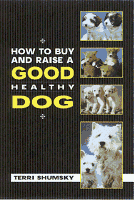 Terri's Book |
Get Terri's Book -- It's excellent! Click the book for more information. -Alex |
 Vassar Square Yorkies That's Shooter's great great grandpa Mr. Skiffington |
Dr. Dale Heisler ...Or a Technical Medical question for Dr. Dale Heisler? |
Buy Yorkie Books On-Line:



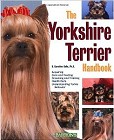

|
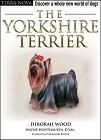



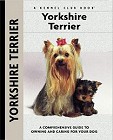

Click the Book Cover for More Information |
